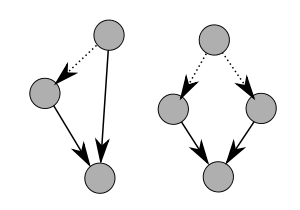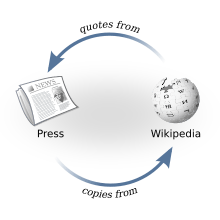Circular reporting
Circular reporting, false confirmation, or citogenesis is a situation in source criticism where a piece of information appears to come from multiple independent sources, but in reality comes from only one source.[1][2] In many cases, the problem happens mistakenly through sloppy intelligence-gathering practices. However, at other times the situation can be intentionally contrived by the original source as a way of reinforcing the widespread belief in its information.[3]

This problem occurs in a variety of fields, including intelligence gathering,[2] journalism, and scholarly research. It is of particular concern in military intelligence because the original source has a higher likelihood of wanting to pass on misinformation, and because the chain of reporting is more prone to being obscured. The case of the 2002 Niger uranium forgeries was a classic instance of circular reporting by intelligence agencies.[4]
Examples involving Wikipedia

Wikipedia is sometimes criticized for being used as a source of circular reporting.[5][6] Wikipedia advises researchers and journalists to be wary of, and generally avoid, using Wikipedia as a direct source, and instead focus on verifiable information found in an article's cited references.[7]
In the following examples, false claims were propagated on Wikipedia and in news sources because of circular reporting. Randall Munroe, in his comic xkcd, called this phenomenon citogenesis.[8]
- Wikipedia and The Northern Echo: In January 2014 a statement was anonymously added to the Wikipedia page on UK comedian/broadcaster Dave Gorman stating that "he had taken a career break for a sponsored hitch-hike around the Pacific Rim countries". When this was questioned, an article published at a later date (September 2014) in The Northern Echo, a daily regional newspaper in North East England was cited as evidence. The falsity of the original claim was confirmed by Gorman in an episode of his UK TV show Modern Life Is Goodish (first broadcast 22 November 2016).[9]
- Wikipedia and Der Spiegel in 2009, regarding Karl-Theodor zu Guttenberg.[10]
- Wikipedia and The Independent in 2007, propagating the false information that Sacha Baron Cohen worked at Goldman Sachs.[11]
- Wikipedia on the coati beginning in 2008, when an arbitrary addition "also known as....the Brazilian aardvark" by an American student resulted in much subsequent citation and usage of the unsubstantiated nickname as part of the general consensus, including published articles in The Independent,[12] the Daily Express,[13] the Metro,[14] The Daily Telegraph,[15] a book published by the University of Chicago,[16] and a scholarly work published by Cambridge University.[17]
See also
References
- Sterzer, Marcus; McDuff, Patrick; Flasz, Jacek (Summer 2008). "Note to File—The Challenge of Centralized Control Faced by the Intelligence Function in Afghanistan" (PDF). Canadian Army Journal. 11.2. Archived from the original (PDF) on 5 March 2012.
- Rozen, Laura (7 June 2008). "The Cocktail Napkin Plan for Regime Change in Iran". Mother Jones. Retrieved 26 June 2019.
- Hurley, Micheal T.; Smith, Kenton V. "Chapter 8: The Aviv Report". I Solemnly Swear: Conmen, Dea, the Media and Pan Am 103. New York: iUniverse. p. 129. ISBN 0-595-29947-4. Retrieved 26 June 2019.
Circular reporting occurs when what is reported is fed back to the originator in revised fashion which makes it difficult to objectively view the end product until you can trace back the sources to determine where the original information actually came from. Pan Am would eventually try to play that game by trying to introduce into court news reports that they themselves had a hand in producing.
- Drogin, Bob; Hamburger, Tom (17 February 2006). "Niger Uranium Rumors Wouldn't Die". Los Angeles Times. Retrieved 26 June 2019.
This became a classic case of circular reporting," said a U.S. intelligence official who spoke on condition of anonymity because he is not authorized to talk to reporters. "It seemed like we were hearing it from lots of places. People didn't realize it was the same bad information coming in different doors. This is an interesting example of circular reporting.
- Timmer, John (8 May 2009). "Wikipedia hoax points to limits of journalists' research". Ars Technica. Retrieved 26 June 2019.
- Harrison, Stephen (7 March 2019). "The Internet's Dizzying Citogenesis Problem". Slate. Retrieved 3 July 2019.
- Wikipedia:Citing Wikipedia
- Munroe, Randall (w, a). "Citogenesis" xkcd 978 (16 November 2011)
- Hardwick, Viv (9 September 2014). "Mears sets his sights on UK". The Northern Echo. Archived from the original on 29 September 2014. Retrieved 26 June 2019.
He once hitchhiked around the Pacific Rim countries
- "Wie ich Freiherr von Guttenberg zu Wilhelm machte". Bildblog (in German). 10 February 2009. Retrieved 26 June 2019.
kdawson (11 February 2009). "False Fact On Wikipedia Proves Itself". Slashdot. Retrieved 26 June 2019. - "Wikipedia Article creates Circular references". Tech Debug. 19 April 2009. Retrieved 26 June 2019.
- Brown, Jonathan (21 June 2010). "From wallabies to chipmunks, the exotic creatures thriving in the UK". The Independent. Archived from the original on 21 May 2014.
Coati (also known as the Brazilian aardvark): found in Cumbria
- Ingham, John (21 June 2010). "Exotic animals could wipe out native wildlife". Daily Express. Retrieved 5 July 2019.
There are also about 10 Brazilian aardvark in Cumbria
- "Scorpions, wallabies and aadvarks 'invading Britain'". Metro. 21 June 2010. Archived from the original on 25 June 2010. Retrieved 5 July 2019.
There are thought to be ten coatis, a kind of Brazilian aardvark, in Cumbria
- Leach, Ben (21 June 2010). "Scorpions, Brazilian aardvarks and wallabies all found living wild in UK, study finds". The Daily Telegraph. Archived from the original on 25 June 2010. Retrieved 5 July 2019.
- Randall, Eric (19 May 2014). "How a Raccoon Became an Aardvark". The New Yorker. Retrieved 26 June 2019.
- Safier, Neil (2014). "Beyond Brazilian Nature: The Editorial Itineraries of Marcgraf and Piso's Historia Naturalis Brasiliae". In Groesen, Michiel van (ed.). The Legacy of Dutch Brazil. New York: Cambridge University Press. p. 179. ISBN 978-1-107-06117-0.
In the case of the Coati, for instance, also known as the Brazilian aardvark, Buffon explained that “Marcgrave, and practically all of the Naturalists after him, said that the aardvark had six toes in its hind feet: M. Brisson is the only one who has not copied this error of Marcgrave.”
- "How false news can spread - Noah Tavlin". TED-Ed. 27 August 2015. Retrieved 26 June 2019.